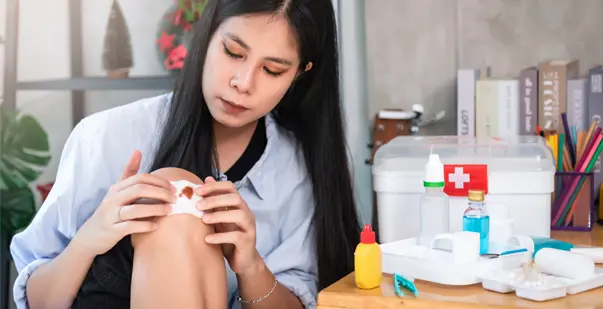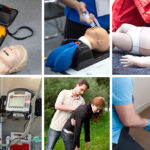We all know that when you have a wound, first aid is given. However, what is first aid? First aid is an initial intervention prior to professional medical help given to an injured person. If your child falls down and has a wound, first aid is administered. Most school teachers, parents, especially mothers administer first aid to their children without much thought. First aid includes cleaning wounds, cuts, minor scrapes, scratches, removing debris from the eyes, cleaning blisters, accidental burns and applying ointments, bandages and dressings to the wounds. This blog looks at understanding the importance of first aid. We will cover the first aid that needs to be given to minor wounds, burns, nosebleeds and more.

Basics of First Aid
Not all adults know how to provide first aid properly. All adults must know about first aid. Some people need to understand the importance of administering first aid at home. If you have elderly parents, understanding first aid could save their life from a shock or cardiac arrest. Older adults are prone to falls, and they could hurt themselves. Treating their wounds will help reduce damage and heal faster. It is a prerequisite that all middle-aged people in the house must find time and take up an accredited first aid certification from a reputed institute without wasting much time.
What is the First Aid for Scrapes and Minor Cuts?
When an adult or child falls down, it is crucial to provide quick treatment to an open wound to minimize the risk of infection and scarring. Continue reading the below points to know what you need to do immediately after getting a cut, scrape, wound, gash or any other injury.
- Ensure you wash your hands to prevent bacteria from entering into the cut or open wound.
- If the wound is bleeding, ensure you take measures to control the bleeding. If the bleeding persists, apply pressure to the cut or wound with a gauze or clean cloth. Continue to do so until the bleeding stops.
- Clean the wound immediately by running cold tap water on the minor scrape. Use sterilized tweezers to remove dirt or debris from the wound. Wash the wound gently using soap.
- Apply petroleum jelly or an antibiotic ointment to the minor cut or wound. It will prevent scarring.
- Cover the wound with a gauze or bandage to avoid infection.
- Ensure to dress the wound at least twice a day. It will keep the wound clean and free of infections.
- Monitor the wound to check for swelling and infection. If the cut or wound is deep, visit the ER, seek professional medical help and get a tetanus shot if required.
You can also use hydrogen peroxide as it is detrimental to wound healing. Here’s how you can use it properly. Hydrogen peroxide works as a wound fighter, disinfectant, stain fighter and cleaner. This antiseptic liquid is the best solution for a scraped knee.
What is the First Aid for Minor Burns?
How do you know if you have a minor burn? A minor burn is less than 8 cm in diameter or 3 inches and is typically characterized by pain, swelling, skin redness and blisters. Here are a few ways first aid should be given:
- Ensure you apply a wet compress or run cold water on the minor burn or affected area until the pain subsides.
- Remove all accessories like rings, bracelets, necklaces, and anklets depending on the location of the minor burn immediately. This will prevent subsequent swelling and minimize post-burn complications.
- Apply a moisturizer or aloe vera that will help soothe the pain.
- In case of blisters, ensure they remain intact and handle them with care. If it is a ruptured blister, apply an antibiotic ointment.
- Protect the minor burn, blister or open wound carefully. Place a bandage or sterile gauze to prevent air exposure which can lead to pain.
What is the First Aid for a Nosebleed?
Knowing how to cook food could save you from starvation. Along the same lines, thorough knowledge of how to treat a deep cut without stitches and treating wounds with first aid can save a life and the lives of the people you love. All you need is a first aid certification from an accredited institution and become a superhero. Below are the steps to stop a nosebleed:
- When treating a nosebleed, it is crucial that the person sit upright and in the forward position. It will reduce the blood pressure which in turn will stop the nosebleed.
- Make sure the person leans forward to prevent the blood from being swallowed. If this happens, it will cause symptomatic distress and upset the stomach.
- Spray a nasal decongestant containing oxymetazoline in each nostril.
- Use your index finger and thumb and pinch your nose while you breathe from your mouth. This will stop the nosebleed as it increases the pressure in the nasal septum. Do this for 10 minutes. If the bleeding does not stop, call 9-1-1.
When should you see a doctor?
While performing first aid, it is important to remember the abbreviation CAB – circulation, airways and breathing. After doing the preliminary checks, call 9-1-1 if the patient’s pulse is faint, if there are breathing problems or if the victim is losing blood or becomes unconscious.
To provide immediate assistance or first aid in the case of injury or to help save a life, it is crucial to think on your toes to prevent further harm in moments that matter.
Conclusion
It is essential to learn adult and child first aid to provide life-saving assistance in an emergency. Parents are more likely to hire first-aid-trained babysitters because of their ability to save lives and prevent health emergencies. Sign up for the American CPR Care Association’s online CPR and First Aid certification course today to learn more about first aid and how to administer it properly. If you have any queries, our team will be happy to assist you.







